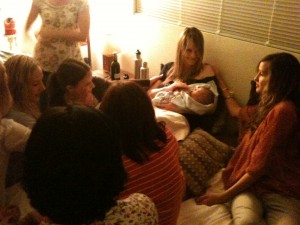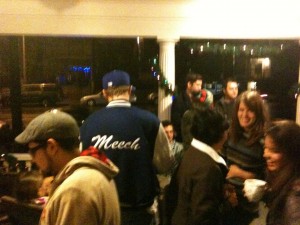This interview was first published on Jamie Arpin-Ricci’s website The Cost of Community. It is a great window in the heart and mission of my work and that of NieuCommunites.
Living as part of an intentional Christian community, I often search for other creative expressions of missional communities around the world. One such example that I love is NieuCommunities. It is also how I came to befriend Jon Huckins (who I finally got to meet in person at InHabit this year), who recently authored the great new book, “Thin Places: 6 Postures for Creating & Practicing Missional Community”.
However, rather than me tell you about it, I thought I would let Jon tell us about it directly. Enjoy!
Jamie Arpin-Ricci: Tell me about NieuCommunities (i.e. some history, current realities & future plans). How did its story result in the book?
Jon Huckins: Over a decade ago a few seasoned leaders and practitioners started regularly gathering at a local taqueria asking the question, “With the Church radically shifting, how can we create a lived, embodied formation experience that will ready young leaders for lives of mission?” They wanted to create a “learning experience” that was not purely academic with the intention of filling pulpits, but a learning experience that would fill neighborhoods with leaders whose lives were radically re-oriented around the life and teachings of Jesus. This small tribe of Kingdom cultivators then gave birth to our first NieuCommunities missional community that was centered around forming the next generation of missionally minded leaders for the Church.
After ten years, lots of refining, tons of shared life and many leaders having been sent on mission into the marketplace, around the globe, into church leadership roles and deep into the fabric of their neighborhood, NieuCommunities now has communities scattered across the globe. While we still pour much of our energy into forming, mentoring and developing young leaders through our 1-2 year apprenticeship, our communities are deeply rooted in neighborhood and are made up of neighbors, apprentices and our staff. Each year we covenant to commune deeply with God, live radically interdependent lives with each other and dive deep into the story(s) of our neighborhood. We gather in our homes, live within 10 minutes walking distance from each other and don’t aspire to accumulate large numbers of people, but to multiply communities that can follow Jesus by living in covenant relationship.
Over the years many individuals and communities have heard our story and asked for some of our “field notes” from our decade of living neighborhood based, street level missional community. This book is our response to that. And while we are far from having all the answers, this is our humble attempt to share our learning’s with the hope of sparking the imagination and practice of individuals and communities across the globe.
JAR: What does “missional community” mean to you? And why are those two words important to each other?
JH: “Missional” has become quite the buzzword and handy adjective for those seeking to jump on the latest ecclesial bandwagon. I’m not saying those are inherently bad, but the last thing we need is more talk about missional…we need embodied, lived expressions of the missional way of life that is rooted in community. I see missional community as two ideas being intimately connected. It is a collection of people that are committed to living lives of mission (apart of the missio dei) who believe the best way to faithfully live on mission is in the context of intentional community. Community fuels and gives context to mission and mission gives purpose and identity to the community.
JAR: Briefly outline the 6 postures you introduce in the book.
JH: We want our posture towards God, our community and our neighborhood to be intimately informed by these commitments. Cloaked in the covering of covenant community, we pilgrimage through each of the following postures as learners and practitioners apprenticing in the way of Jesus:
Listening: We desire to be attuned to God, to self, and to our neighborhood.
Submerging: We desire to embody Jesus in our neighborhood by diving deep into the narratives that are often ignored, misunderstood or without a voice.
Inviting: We desire to grasp the depth of God’s invitation to kingdom life and to become more inviting (and invited!) people while welcoming our neighbors into God’s redemptive story.
Contending: We desire to confront the things that hinder the full expression of the kingdom of God, both spiritual and natural, in our community, among our friends and neighbors, and in our city.
Imagining: We desire to discern God’s intent on our lives and help shape transformational faith communities.
Entrusting: We desire to entrust people to God and to others, celebrate our deeper understanding of God’s call on our lives, and lean confidently into our future.
JAR: Name a few authors/books who have been particularly formative for you & NieuCommunities. How so?
JH: These books and authors have done well at rooting us deep in the Story of God, while learning from traditions that daily inform our life and practice (namely, Celtic Spirituality). Further, we will often read these books as a community based on the current posture we are navigating together.
The Celtic Way of Evangelism, George Hunter
Spiritual Direction, Henri Nouwen
Life Together, Dietrich Bonhoeffer
Irresistible Revolution, Shane Claiborne
Making Room: Recovering Hospitality as a Christian Tradition, Christine Pohl
Jesus and the Victory of God – N.T. Wright
The Divine Conspiracy, Dallas Willard
Celebration of Discipline, Richard Foster
Theology for the Community of God, Stanley Grenz
The Mission of God, Christopher Wright
JAR: What is your biggest concern for the church today and why?
JH: My greatest concern for the Church is that it would loose sight of its vocation of living as a sent people. The Western Church of the last 100 years as largely turned towards ecclesial models that promote consumption rather than participation. People often leave/drive from their local contexts to attend a church gathering in a building where a person(s) lead the rest of the congregation in some form of worship and teaching. The people then drive back to their neighborhoods having received something for themselves. While this is certainly not all bad and great things have and continue to happen in these contexts, this model has largely debilitated the vocation of the People of God. In this model it is easy to think that only the “pastor” has been sent to share the Good News of Jesus (which is often viewed synonymously with spoken word rather than lived life), so we are simply to bring people to a service or gathering to hear him/her share. The Good News is removed from the context of everyday life in our neighborhoods, revolves around a service that requires a vast amount of resources and is something we only hear rather than embody.
We believe we are not only to share the Good News, but embody the Good News. Jesus extends his vocation of redemption and restoration to humanity to accept and participate in. When the church simply becomes a place or a commodity, we are greatly debilitated in living out our vocation as sent ones for the benefit of the cosmos. In other words, whether we are sent across the world or across the street, we are all missionaries. Until the Church sees its role to multiply Kingdom participants on mission rather than offering goods and services to consumers, the influence and prophetic presence of the Church will be greatly diminished. Thankfully, there is a Spirit-driven movement afoot that is growing, grass-roots and poised to radically reorient the Church around the life and teachings of Jesus.
JAR: Thanks Jon.



